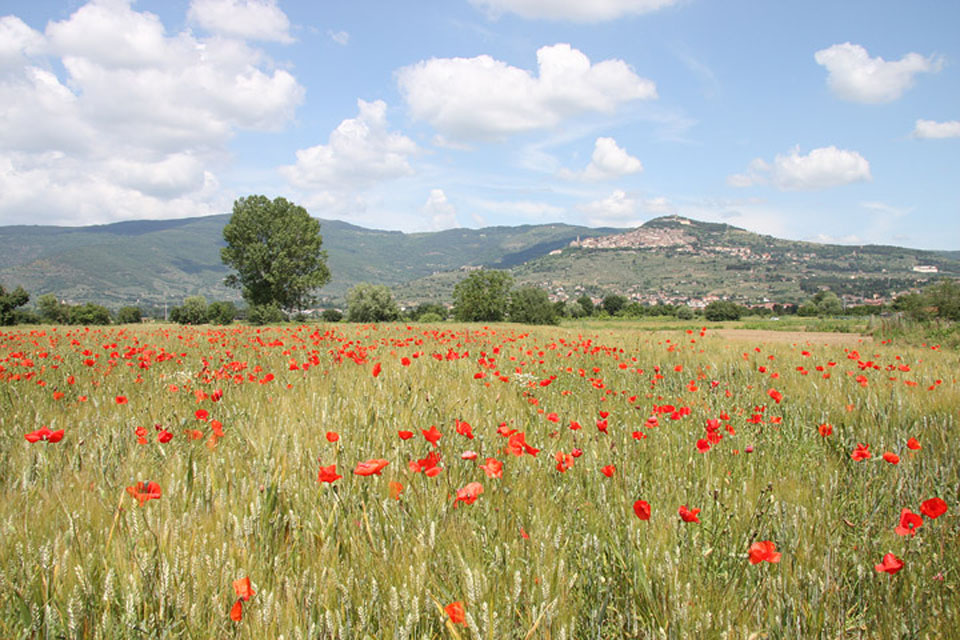Cortona, one of the most beautiful villages in Italy

According to the legend, as told by Roman poet Virgil, the city of Cortona was founded by Dardanus, exactly where the mythical hero during battle lost his helmet (Corys), hence the name Corito, which later became Cortona. Originally one of the Etruscan powers, Cortona, which some Greek authors identify as Ulysses' place of death, was conquered by the Romans and later on by the Goths, prior to becoming a "free commune" in the 12th century, when it enjoyed its golden age. The city center unfolds in a warren of steep alleyways, paved with flagstones and flanked by numerous buildings dating from the Middle Ages and the Renaissance. The most symbolic sights, or better still, the emblems of the city center are: Piazza della Repubblica and the nearby Palazzo Pretorio, housing the new MAEC museum (Museo dell'Accademia Etrusca e della città di Cortona). Among the most important artifacts unearthed locally and preserved in the museum are: the famous Lampadario (Etruscan hanging lamp) dating from the 5th century BC, the "Polymnia Muse", an encaustic painting of the Roman era, the "Tabula Cortonensis", a bronze tablet inscribed with Etruscan text, and the precious collections of Etruscan jewelry. The sightseeing tour of the Etruscan and Roman city of Cortona cannot be complete without a visit to the famed "Porta Bifora" ––the double-arched and last-remaining gate in the Etruscan-medieval defensive walls––, the Roman aqueduct and the Archaeological Park, to discover the burial mound with its stairway, embellished by a carved balustrade and architectural elements of orientalizing style, and leading to a platform for funerary rites, unearthed during the 90s. The Diocesan Museum (Museo Diocesano), another treasure trove of wonders, sits opposite the Cathedral and houses The Annunciation, a panel-painting altarpiece by Fra Angelico, as well as works by other prominent Tuscan artists, including Luca Signorelli, who was born in Cortona. Apart from the Cathedral, other must-see churches are: the Church of St. Francis, of gothic origin and recently renovated, the Sanctuary of St. Margaret, where the body of the Saint, who died in 1362, is preserved in a shrine, and the churches Santa Maria Nuova, San Nicolò and San Marco. In the upper part of the town lies the Medicean fortress, offering a breathtaking view of the surrounding landscape, while to the north-east, just outside the city walls, you can visit the Franciscan Hermitage Le Celle (Eremo delle Celle), the beautiful monastery of the Capuchin friars founded by Saint Francis in 1211. An opportunity for an unforgettable experience is to visit the places featured in famous movies set precisely in this lovely city of Valdichiana, such as: Under the Tuscan Sun, based on the bestseller by Frances Mayers, Certified Copy, starring Juliette Binoche, and the award-winning Life Is Beautiful, by Roberto Benigni. Throughout the year Cortona hosts a great number of cultural, historical and wine-and-food events: the crossbow competition Giostra dell'Archidado, the Mix Festival, mingling literature, music, cinema, dance and theatre, and the photo festival Cortona on the move, just to name a few. Finally, Lake Trasimeno is well worth a visit, or at least a bird's-eye view from the belvedere of Garibaldi Square (Piazzale Garibaldi), offering a superb panorama of the lake and its islands, as well as a description of the site where the Battle of Lake Trasimeno took place in 217 BC between Hannibal and the Roman legions, led by consul Flaminius.
Via Casali, 6 52044 Cortona, Italia tel +39 0575 653 125 roggicortona@gmail.com
Via del Marzocco, 5 55045 Pietrasanta, Italia tel +39 0584 332 300 roggipietrasanta@gmail.com
Via Palestro, 2 53037 San Gimignano, Italia tel +39 0577 940 760 roggisangimignano@gmail.com
mob +39 333 6461 405
